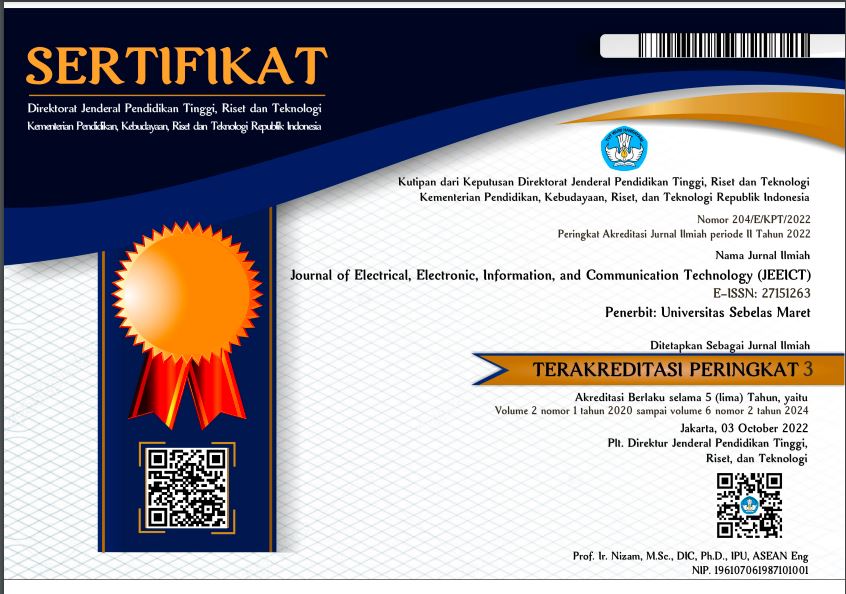Glucose Detection Based on Light Reflection in Modulated Optical Fibers for Continuous Diabetes Monitoring
Abstract
Full Text:
PDFReferences
International Diabetes Federation, “IDF Diabetes Atlas 10th edition,” 2021. [Daring]. Tersedia pada: www.diabetesatlas.org
H. W. Baynest, “Classification, Pathophysiology, Diagnosis and Management of Diabetes Mellitus,” J. Diabetes Metab., vol. 06, no. 05, 2015, doi: 10.4172/2155-6156.1000541.
Departemen Kesehatan RI, “IDN_D1_Diabetes guidlines,” Jakarta, 2006.
M. S. Gianti et al., “Low‐cost fabrication of indium tin oxide (ITO) FETs for sodium detection in electrolytes and human urine,” Electron. Lett., hal. 5–7, 2021, doi: 10.1049/ell2.12228.
W. Xu et al., “Rapid and non-invasive diagnosis of type 2 diabetes through sniffing urinary acetone by a proton transfer reaction mass spectrometry,” Talanta, vol. 256, hal. 124265, Mei 2023, doi: 10.1016/J.TALANTA.2023.124265.
T. Shang et al., “Products for Monitoring Glucose Levels in the Human Body With Noninvasive Optical, Noninvasive Fluid Sampling, or Minimally Invasive Technologies,” J. Diabetes Sci. Technol., vol. 16, no. 1, hal. 168, Jan 2022, doi: 10.1177/19322968211007212.
J. Kottmann, J. M. Rey, dan M. W. Sigrist, “Mid-infrared photoacoustic detection of glucose in human skin: Towards non-invasive diagnostics,” Sensors (Switzerland), vol. 16, no. 10, Okt 2016, doi: 10.3390/s16101663.
A. Zendehnam, M. Mirzaei, A. Farashiani, dan L. H. Farahani, “Investigation of bending loss in a single-mode optical fiber,” Indian Acad. Sci., vol. 74, no. 4, hal. 591–603, 2010.
N. Hidayah Sulaiman, H. Abdul Razak, H. Haroon, A. Suhaila Mohd Zain, dan S. H. S. M. Fadzullah, “Sensitivity enhancement of singlemode-multimode-singlemode fiber optic sensor based on macrobending effect for food composition monitoring,” in Journal of Physics: Conference Series, Mar 2019, vol. 1151, no. 1. doi: 10.1088/1742-6596/1151/1/012026.
D. M. C. Rodrigues, R. N. Lopes, M. A. R. Franco, M. M. Werneck, dan R. C. S. B. Allil, “Sensitivity analysis of different shapes of a plastic optical fiber-based immunosensor for Escherichia coli: Simulation and experimental results,” Sensors (Switzerland), vol. 17, no. 12, hal. 1–16, 2017, doi: 10.3390/s17122944.
S. Afraghassani dan S. Ambar Wulan Fisika, “Glutic. Rancang Bangun Alat Pendeteksi GLukosa Urin Berbasis Teknologi Sensor Serat Optik untuk Diagnosis Dini Diabetes,” J. Penelit. dan Penal., vol. 6, 2019, [Daring]. Tersedia pada: http://journal.unismuh.ac.id/
A. Gowri dan V. V. R. Sai, “Development of LSPR based U-bent plastic optical fiber sensors,” Sensors Actuators, B Chem., vol. 230, hal. 536–543, 2016, doi: 10.1016/j.snb.2016.02.074.
Ghatak Ajoy dan Thyagarajan K., Introduction to Fiber OPtics. Cambridge University Press, 1998.
M. Yunianto, A. Marzuki, dan Z. Ismail, “Desain Alat Ukur Rugi-Rugi Akibat Macrobending pada Multi-Mode Optical Fiber Berbasis Personal Computer,” Indones. J. Appl. Phys., vol. 2, no. 2, hal. 2089–0133, 2012.
I. Ristika, R. Barani, S. N. Sari, J. Teknik, E. Fakultas, dan T. Universitas, “Pengaruh rugi-rugi macrobending terhadap kinerja plastic optical fiber jenis step index multimode,” J. Tek. Elektro Fak. Tek. Univ. Brawijaya, no. Ld, hal. 1–6, 2013.
J. L. Tang, S. F. Cheng, W. T. Hsu, T. Y. Chiang, dan L. K. Chau, “Fiber-optic biochemical sensing with a colloidal gold-modified long period fiber grating,” Sensors Actuators, B Chem., vol. 119, no. 1, hal. 105–109, Nov 2006, doi: 10.1016/j.snb.2005.12.003.
Crisp John, Introduction to Fiber Optics, 2nd ed. oxford: Newnes, 2001.
Z. Gong et al., “Wearable fiber optic technology based on smart textile: A review,” Materials, vol. 12, no. 20. MDPI AG, 1 Oktober 2019. doi: 10.3390/ma12203311.
Refbacks
- There are currently no refbacks.







